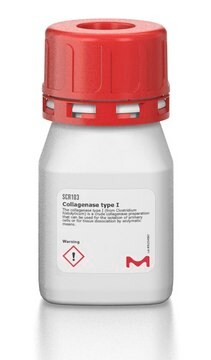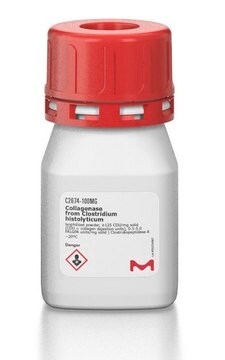C7926
Collagenase from Clostridium histolyticum
Sigma Blend Type F, ≥2.0 FALGPA units/mg solid
Synonym(s):
Clostridiopeptidase A
Sign Into View Organizational & Contract Pricing
All Photos(4)
About This Item
Recommended Products
biological source
Clostridium histolyticum
Quality Level
form
powder
caseinase activity
≤10 units/mg solid
specific activity
≥2.0 FALGPA units/mg solid
mol wt
68-130 kDa
storage temp.
−20°C
Looking for similar products? Visit Product Comparison Guide
Application
Collagenase from Clostridium histolyticum has been used in determining the degradation rate of collagen biomaterials. It may also be used to determine the enzymatic degradation and enzymatic resistance by the liberated L-leucine measurements.
Collagenase from Clostridium histolyticum, or Clostridiopeptidase A, has been used in a study to assess contact dermatitis with clostridiopeptidase A contained in Noruxol ointment. Clostridiopeptidase A has also been used in a study to investigate the early and successful enzymatıc debridement via collagenase application to pinna in a preterm neonate.
The enzyme has been used in the isolation of mast cells from adult mice. This study generated a large number of connective tissue-type mast cells by the culture of murine fetal skin cells. The product has also been used in the in vitro biodegradation study of Bombyx mori silk fibroin fibers and films, by exposing them to the enzyme for varied time periods.
Biochem/physiol Actions
Effective release of cells from tissue requires the action of collagenase enzymes and the neutral protease. Collagenase is activated by four gram atom calcium (Ca2+) per mole enzyme. The culture filtrate is thought to contain at least 7 different proteases ranging in molecular weight from 68-130 kDa. The pH optimum is 6.3-8.8. The enzyme is typically used to digest the connective components in tissue samples to liberate individual cells. Ethylene glycol-bis(β-aminoethyl ether)-N,N,N′,N′-tetraacetic acid (EGTA)4; β-mercaptoethanol; glutathione, reduced; thioglycolic acid, sodium; and 2,2′-dipyridyl; 8-hydroxyquinoline are known to inhibit the enzyme activity.
Collagenase is activated by four gram atom calcium per mole enzyme. It is inhibited by ethylene glycol-bis(beta-aminoethyl ether) - N, N, N′,N′-tetraacetic acid, beta-mercaptoethanol, glutathione, thioglycolic acid and 8-hydroxyquinoline.
Unit Definition
One collagen digestion unit (CDU) liberates peptides from collagen from bovine achilles tendon equivalent in ninhydrin color to 1.0 μmole of leucine in 5 hours at pH 7.4 at 37 °C in the presence of calcium ions. One FALGPA hydrolysis unit hydrolyzes 1.0 μmole of furylacryloyl-Leu-Gly-Pro-Ala per min at 25°C. One Neutral Protease unit hydrolyzes casein to produce color equivalent to 1.0 μmole of tyrosine per 5 hr at pH 7.5 at 37°C. One Clostripain Unit hydrolyzes 1.0 μmole of BAEE per min at pH 7.6 at 25°C in the presence of DTT.
Signal Word
Danger
Hazard Statements
Precautionary Statements
Hazard Classifications
Eye Irrit. 2 - Resp. Sens. 1 - Skin Irrit. 2 - STOT SE 3
Target Organs
Respiratory system
Storage Class Code
11 - Combustible Solids
WGK
WGK 1
Flash Point(F)
Not applicable
Flash Point(C)
Not applicable
Personal Protective Equipment
dust mask type N95 (US), Eyeshields, Gloves
Choose from one of the most recent versions:
Already Own This Product?
Find documentation for the products that you have recently purchased in the Document Library.
Customers Also Viewed
Properties of collagen and hyaluronic acid composite materials and their modification by chemical crosslinking
Rehakova M, et al.
Journal of Biomedical Materials Research, 30(3), 369-372 (1996)
Biodegradation of Bombyx mori silk fibroin fibers and films.
Arai T, et al.
Journal of Applied Polymer Science, 91(4), 2383-2390 (2004)
Nobuo Yamada et al.
The Journal of investigative dermatology, 121(6), 1425-1432 (2003-12-17)
We describe a novel culture system for generating large numbers of murine skin-associated mast cells and distinguish their characteristics from bone marrow-derived cultured mast cells. Culture of day 16 fetal skin single cell suspensions in the presence of interleukin-3 and
K Vizárová et al.
Biomaterials, 16(16), 1217-1221 (1995-11-01)
Two kinds of layered atelocollagen materials cross-linked with hexamethylene diisocyanate (HMDIC), starch dialdehyde and glyoxal were enzymatically treated by bacterial collagenase. Evaluating collagenase digestion assay for these material showed progressive differences, particularly in the group of samples cross-linked with HMDIC.
Tyler J Chozinski et al.
Scientific reports, 8(1), 10396-10396 (2018-07-12)
Although light microscopy is a powerful tool for the assessment of kidney physiology and pathology, it has traditionally been unable to resolve structures separated by less than the ~250 nm diffraction limit of visible light. Here, we report on the optimization
Protocols
This procedure may be used for Collagenase products.
Our team of scientists has experience in all areas of research including Life Science, Material Science, Chemical Synthesis, Chromatography, Analytical and many others.
Contact Technical Service


![N-[3-(2-Furyl)acryloyl]-Leu-Gly-Pro-Ala](/deepweb/assets/sigmaaldrich/product/structures/805/876/96b5fb57-71c8-4c6b-b5d2-fafe7374cd85/640/96b5fb57-71c8-4c6b-b5d2-fafe7374cd85.png)




